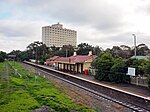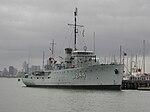Williamstown Cricket Ground
Buildings and structures in the City of Hobsons BayCricket ground stubsCricket grounds in Victoria (state)Sport in the City of Hobsons BaySports venues in Melbourne ... and 2 more
Victorian Football League groundsWilliamstown, Victoria

The Williamstown Cricket Ground, currently known by its sponsored name DSV Stadium, and also informally as Point Gellibrand Oval, is a football and cricket stadium located in Williamstown, Victoria. The ground is located on Point Gellibrand, the southernmost point of Williamstown which juts into Port Phillip Bay. The ground is currently the home of the Williamstown Football Club in the Victorian Football League, and the Williamstown Cricket Club in the Victorian Sub-District Cricket Association.
Excerpt from the Wikipedia article Williamstown Cricket Ground (License: CC BY-SA 3.0, Authors, Images).Williamstown Cricket Ground
Battery Road, Melbourne Williamstown
Geographical coordinates (GPS) Address Nearby Places Show on map
Geographical coordinates (GPS)
| Latitude | Longitude |
|---|---|
| N -37.871111111111 ° | E 144.90333333333 ° |
Address
Williamstown Football Ground
Battery Road
3016 Melbourne, Williamstown
Victoria, Australia
Open on Google Maps







